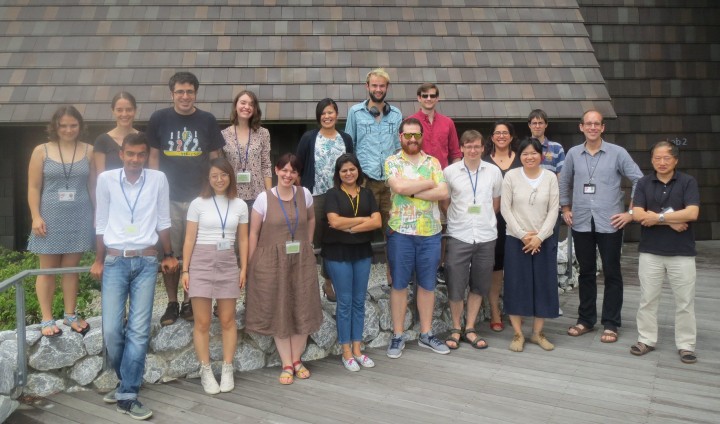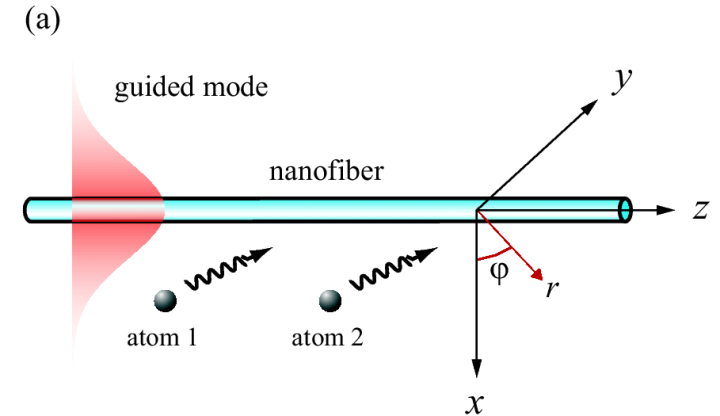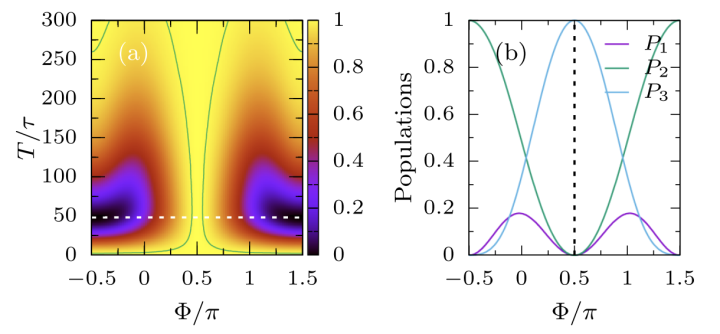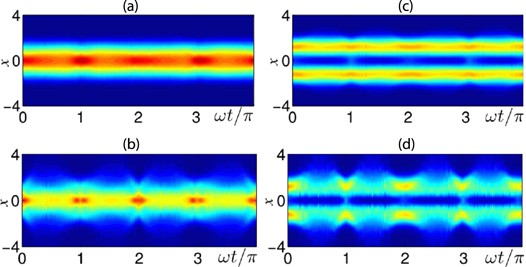Quantum Systems Unit
Professor Thomas Busch
Abstract
In the past year we have focused on vortex dynamics in Bose-Einstein condensates, quantum engineering of ultracold atom systems through shortcuts to adiabaticity, the description of quantum thermodynamics properties in strongly correlated quantum systems, spin-orbit coupled BECs and several other topics.
1. Staff
- Dr. Yongping Zhang, Postdoctoral Scholar
- Dr. Albert Benseny Cases, Postdoctoral Scholar
- Dr. Angela White, Postdoctoral Scholar
- Dr. Rashi Sachdeva, Postdoctoral Scholar
- Dr. Thomás Fogarty, Postdoctoral Scholar
- Dr. Pham Le Kien, Staff Scientist
- Dr. Matthew Edmonds, JSPS Fellow
- Mr. Lee O'Riordarn, PhD Student
- Ms. Irina Reshodko, PhD Student
- Mr. Jiabao Chen, PhD Student
- Mr. James Schloss, PhD Student
- Mr. Mathias Mikkelsen, PhD Student
- Ms. Seyedeh Sahar Seyed Hejazi, PhD Student
- Ms. Sawako Koki, Research Unit Administrator
Rotation Students
- Ms. Cindy Esporlas (May-September, 2016)
- Ms. Ayaka Usui (September-December, 2016)
- Mr. Andreas Thomasen (September-December, 2016)
- Ms. Kimberly Remund (January-April, 2017)
- Ms. Evropi Toulkeridou (January-March, 2017)
Research Interns
- Mr. Abasalt Bahrami, University of Sao Paulo, Brazil (December 22, 2016 - May 20, 2017)*FY15-16
- Mr. Christopher Campbell, National University of Ireland Galway, Ireland (Feb 10 - July 13) *FY15-16
- Ms. Susmita Singh, Indian Institute of Science Education and Research, Pune, India (May 24 - July 29)
- Mr. Alfonso Martinez, Autonomous University of Barcelona, Spain (July 07 - Sep 05)
- Ms. Holly Herbert, Trinity College Dublin, Ireland (July 25 - Sep 15)
- Mr. David Gunn, University of St. Andrews, UK (Oct 03 - Feb 24)
- Ms. Tiantian Zhang, Norwegian University of Science and Technology, Norway (Feb 08 - Aug 04) *FY16-17
2. Collaborations
2.1 Optimal Conditions for SAP
- Type of collaboration: Joint research
- Researchers:
- Prof. J. Mompart, Universitat Autonoma de Barcelona, Spain
- Prof. V. Ahufinger, Universitat Autonoma de Barcelona, Spain
2.2 Quantum Thermodynamics
- Type of collaboration: Joint research
- Researchers:
- Prof. M. Paternostro, Queen's University Belfast, Northern Ireland
- Dr. S. Campbell, Queen's University Belfast, Northern Ireland
- Dr. M.A. Garcia March, ICFO, Castelldefels, Spain
2.3 Spin-Orbit Coupling in Bose-Einstein condensates
- Type of collaboration: Joint research
- Researchers:
- Prof. P. Engels, Washington State University, US
- M.E. Mossman, Washington State University, US
2.4 Shortcuts to adiabaticity
- Type of collaboration: Joint research
- Researchers:
- Dr. A. Ruschhaupt, University College Cork, Ireland
- Mr. A. Kiely, University College Cork, Ireland
2.5 Extended Bose Hubbard physics for two leg ladder configuration
- Type of collaboration : Joint research
- Researchers :
- Dr. M. Singh, Physical Research Laboratory, Ahmedabad, India
2.6 BECs in antidot lattices
- Type of collaboration: Joint research
- Researchers:
- Prof. T. Kinoshita, Kyoto University
3. Activities and Findings
3.1 Nanofiber-Mediated Chiral Radiative Coupling Between Two Atoms
Radiative coupling between two atoms has been a topic of great interest for the past several decades and the range and strength of the coupling can be enhanced by means of suitable environments. In this project we have studied the radiative coupling between two two-level atoms with arbitrarily polarized dipoles in the vicinity of a nanofiber. We have focused on the case where the atomic dipoles are circularly polarized and, consequently, the rate of emission is depending on the propagation direction, that is, the radiative interaction between the atoms is chiral. In order to get insight into this chiral coupling, we have looked at the decay behavior of the atoms as well as the fluxes and numbers of photons emitted into guided modes and obtained expressions for the single-atom and cross-atom decay coefficients and their directional components. The chiral radiative coupling was found to modify the collective emission of the atoms and the modifications strongly depend on the initial state of the atomic system, the radiative transfer direction, the distance between the atoms, and the distance from the atoms to the fiber surface.
3.2 Spatial non-adiabatic passage using geometric phases
Quantum technologies based on adiabatic techniques can be highly effective, but often at the cost of being very slow. In this work we have introduced a set of experimentally realistic, non-adiabatic protocols for spatial state preparation, which yield the same fidelity as their adiabatic counterparts, but on fast timescales. In particular, we have considered a charged particle in a system of three tunnel-coupled quantum wells, where the presence of a magnetic field can induce a geometric phase during the tunnelling processes. We showed that this leads to the appearance of complex tunnelling amplitudes and allows for the implementation of spatial non-adiabatic passage. We have demonstrate the ability of such a system to transport a particle between two different wells and to generate a delocalised superposition between the three traps with high fidelity in short times.
3.3 Topological defect dynamics of vortex lattices in Bose-Einstein condensates
Vortex lattices in rapidly rotating Bose-Einstein condensates are systems of topological excitations that arrange themselves into periodic patterns. In this project we have shown how phase-imprinting techniques can be used to create a controllable number of defects in these lattices and examined the resulting dynamics. Even though ultracold atomic condensates are usually described using the mean-field Gross-Pitaevskii theory, the full range of many-particle effects among the vortices can be studied in this way. In particular we have shown the existence of localized vacancies that are quasistable over long periods of time and characterized the effects on the background lattice through the use of the orientational correlation function and Delaunay triangulation.
3.4 Non-equilibrium thermodynamics of harmonically trapped bosons
We have appled the framework of non-equilibrium quantum thermodynamics to the physics of quenched small-sized bosonic quantum gases in a one-dimensional harmonic trap. We have shown that dynamical orthogonality can occur in these few-body systems with strong interactions after a quench and we have found its occurrence analytically for an infinitely repulsive pair of atoms. This phenomena is related to the fundamental excitations that dictate the dynamics from the spectral function and we were able to establish a clear qualitative link between the amount of (irreversible) work performed on the system and the establishment of entanglement. Extending our analysis to multipartite systems by examining the case of three trapped atoms, we were able to show that the initial (pre-quench) interactions play a vital role in determining the dynamical features, while the qualitative features of the two particle case appear to remain valid. Finally, we have proposed the use of the atomic density profile as a readily accessible indicator of the non-equilibrium properties of the systems in question.
4. Publications
4.1 Journals
- Spatial non-adiabatic passage using geometric phases
Albert Benseny, Anthony Kiely, Yongping Zhang, Thomas Busch, and Andreas Ruschhaupt
Eur. Phys. J. Quantum Technol.4:3 (2017) - Nanofiber-mediated chiral radiative coupling between two atoms
Fam Le Kien and A. Rauschenbeutel
Phys. Rev. A 95, 023838 (2017) - Creating superfluid vortex rings in artificial magnetic fields
Rashi Sachdeva and Thomas Busch
Physical Review A 95, 033615 (2017) - Dynamical polarizability, screening, and plasmons in one, two, and three dimensional massive Dirac systems
Anmol Thakur, Rashi Sachdeva, and Amit Agarwal
J. Phys. Condensed Matter 29, 105701 (2017) - Probing the out-of-equilibrium dynamics of two interacting atoms
Tim Keller and Thomás Fogarty
Phys. Rev. A94, 063620 (2016) - Optimal conditions for spatial adiabatic passage of a Bose-Einstein condensate
J. L. Rubio, V. Ahufinger, Th. Busch, and J. Mompart
Phys. Rev. A 94, 053606 (2016) - Topological defect dynamics of vortex lattices in Bose-Einstein condensates
Lee James O'Riordan, Thomas Busch
Phys. Rev. A 94, 053603 (2016) - Non-equilibrium thermodynamics of harmonically trapped bosons
Miguel Ángel García-March, Thomás Fogarty, Steve Campbell, Thomas Busch and Mauro Paternostro
New J. Phys. 18, 103035 (2016) - On the classical Schrödinger equation
Albert Benseny, David Tena and Xavier Oriols
Fluct. Noise Lett. 15, 1640011 (2016) - Shaken not stirred: creating exotic angular momentum states by shaking an optical lattice
Anthony Kiely, Albert Benseny, Thomas Busch and Andreas Ruschhaupt
J. Phys. B: At. Mol. Opt. Phys. 49, 215003 (2016) - Optomechanical many-body cooling to the ground state using frustration
Thomás Fogarty, Haggai Landa, Cecilia Cormick, Giovanna Morigi
Phys. Rev. A 94, 023844 (2016) - Localization transition in presence of cavity backaction
Katharina Rojan, Rebecca Kraus, Thomás Fogarty, Hessam Habibian, Anna Minguzzi, Giovanna Morigi
Phys. Rev. A 94, 013839 (2016) - Properties of spin–orbit-coupled Bose–Einstein condensates
Y. Zhang, M.E. Mossman, Th. Busch, P. Engels, C. Zhang
Front. Phys. 11, 118103 (2016). - Spatial adiabatic passage: a review of recent progress
R. Menchon-Enrich, A. Benseny, V. Ahufinger, A.D. Greentree, Th. Busch, and J. Mompart
Rep. Prog. Phys. 79, 074401 (2016).
4.2 Books and other one-time publications
Nothing to report
4.3 Oral and Poster Presentations
4.3.1 Conference Oral Presentation
- Busch, T. Engineering of Quantum Systems by Controlling Interactions, Many-body Physics in Synthetic Quantum Systems, Stellenbosch, South Africa, 7 April (2016)
- White, A. Superflows in multicomponent Bose-Einstein condensates, Coherent Control of Complex Quantum Systems (C3QS) 2016, Okinawa, Japan, 20 April (2016)
- Benseny, A. SAP beyond STIRAP: interactions, higher dimensions and shortcuts, Mini Symposium: Spatial Adiabatic Passage, Okinawa, Japan, 26 May (2016)
- White, A. Emergence of classical rotation in superfluid Bose-Einstein condensates, Multicomponent Atomic Condensates and Rotational Dynamics (MACRO) conference and JQC Symposium, Newcastle, UK, 15 September (2016)
- Le Kien, F. Selected topics of nanofiber optics, Okinawa School in Physics: Coherent Quantum Dynamics (CQD) 2016, Okinawa, Japan, 4 October (2016)
- Sachdeva, R. Creating vortex rings in BEC in artificial magnetic fields using optical nanofibers, The 4th International workshop on Optical Nanofiber applications (ONNA 2016), Hangzhou, China, 24 October (2016)
- Benseny, A. Spatial non-adiabatic passage processes in quantum dots, JPS 72th Annual Meeting, Osaka, Japan, 17 March (2017)
- Busch, T. Quantum engineering of many-particle systems with high fidelities, JPS 72th Annual Meeting, Osaka, Japan, 17 March (2017)
- Fogarty, T. Shortcuts to adiabaticity in the Feshbach engine, JPS 72th Annual Meeting, Osaka, Japan, 17 March (2017)
- Le Kien, F. Nanofiber-Mediated Chiral Radiative Coupling between Two Atoms, JPS 72th Annual Meeting, Osaka, Japan, 17 March (2017)
- Reshodko, I. Deterministic dispenser of massive bosonic particles, JPS 72th Annual Meeting, Osaka, Japan, 17 March (2017)
- Schloss, J. Controlling vortex rings in Bose-Einstein condensates using artificial gauge fields, JPS 72th Annual Meeting, Osaka, Japan, 17 March (2017)
- Usui, A. Dynamical Phase Transition of a Tonks-Girardeau Gas, JPS 72th Annual Meeting, Osaka, Japan, 17 March (2017)
- White, A. Rotational properties of multi-component superfluid Bose-Einstein condensate, JPS 72th Annual Meeting, Osaka, Japan, 17 March (2017)
- S. Hejazi, S. S. Tuning interatomic resonance interactions between two atoms close, JPS 72th Annual Meeting, Osaka, Japan, 18 March (2017)
- Sachdeva, R. Extended Bose Hubbard model for two leg ladder in artificial magnetic field, JPS 72th Annual Meeting, Osaka, Japan, 18 March (2017)
- Thomasen, A. Characterising chaotic dynamics of quantum vortices in Bose-Einstein condensates, JPS 72th Annual Meeting, Osaka, Japan, 18 March (2017)
4.3.2 Conference Poster Presentation
- Benseny, A., Kiely, A., Gillet, J., Zhang, Y., Ruschhaupt, A., Busch, T. SAP beyond STIRAP: interactions, higher dimensions and shortcuts, Coherent Control of Complex Quantum Systems (C3QS) 2016, Okinawa, Japan, 18-21 April (2016)
- García-March, M. A., Fogarty, T., Campbell, S., Busch, T., Paternostro, M. Non-Equilibrium Thermodynamics of Harmonically Trapped Bosons, Coherent Control of Complex Quantum Systems (C3QS) 2016, Okinawa, Japan, 18-21 April (2016)
- Mikkelsen, M. Non-linear optomechanical coupling of a membrane to a cavity, Coherent Control of Complex Quantum Systems (C3QS) 2016, Okinawa, Japan, 18-21 April (2016)
- O'Riordan, L.Dynamics of large vortex lattice carrying Bose-Einstein condensates, Coherent Control of Complex Quantum Systems (C3QS) 2016, Okinawa, Japan, 18-21 April (2016)
- Reshodko, I., Benseny, A., Gillet, J., Busch, T. High-fidelity Creation of Two-particle Quantum States Via Spatial Adiabatic Passage, Coherent Control of Complex Quantum Systems (C3QS) 2016, Okinawa, Japan, 18-21 April (2016)
- Sachdeva, R., Busch, T. Creating vortex rings in BECs in artificial magnetic fields, Coherent Control of Complex Quantum Systems (C3QS) 2016, Okinawa, Japan, 18-21 April (2016)
- S. Hejazi, S. S., White, A., Busch, T. Quantum walk and 2D phase, Coherent Control of Complex Quantum Systems (C3QS) 2016, Okinawa, Japan, 18-21 April (2016)
- White, A., Hennessy, T., Busch, T. Emergence of classical rotation in superfluid Bose-Einstein condensates, 616. WE-Heraeus-Seminar: Ultracold Quantum Gases - Current Trends and Future Perspectives, Bad Honnef, Germany, 9, 10, 12 May (2016)
- Benseny, A.Moving particles using tunnelling: spatial adiabatic passage, Okinawa School in Physics: Coherent Quantum Dynamics (CQD) 2016, Okinawa, Japan, 28, 30 September (2016)
- Mikkelsen, M.Non-linear optomechanical coupling of a membrane to a cavity, Okinawa School in Physics: Coherent Quantum Dynamics (CQD) 2016, Okinawa, Japan, 28, 30 September (2016)
- Sachdeva, R.Creating vortex rings in BECs in artificial magnetic field, Okinawa School in Physics: Coherent Quantum Dynamics (CQD) 2016, Okinawa, Japan, 28, 30 September (2016)
- Schloss, J.NOON states with optimal control, Okinawa School in Physics: Coherent Quantum Dynamics (CQD) 2016, Okinawa, Japan, 28, 30 September (2016)
- White, A.Solid body rotation of two-component Bose-Einstein condensates, Okinawa School in Physics: Coherent Quantum Dynamics (CQD) 2016, Okinawa, Japan, 28, 30 September (2016)
- Sachdeva, R., Schloss, J., Busch, T. Controlling superfluid vortex rings using artificial magnetic fields, 632. WE-Heraeus-Seminar- Gauge Field Dynamics with Ultracold Gas Systems, Bad Honnef, Germany, 12-13 December (2016)
4.3.3 Seminar
- Busch, T. Quantum Engineering of Atomic Systems with High Fidelities, National Institute for Theoretical Physics, South Africa, 1 April (2016)
- White, A. Superfluid Rotation in multi-component Bose-Einstein condensates, Newcastle University, UK, 17 May (2016)
- Fogarty, T. Optomechanical many-body cooling to the ground state using frustration, Shanghai Univeristy, China, 8 September (2016)
- White, A. Superflows in multi-component Bose-Einstein condensates, The University of Queensland, Australia, 20 December (2016)
- Busch, T. Engineering of Quantum Systems by Controlling Interactions, University of Kaiserslautern, Germany, 21 December (2016)
- Benseny, A. Spatial adiabatic passage: interactions, particle separation, and shortcuts, Complutense University of Madrid, Spain
- Benseny, A. SAP beyond STIRAP: interactions, particle separation, and shortcuts, Institute of Materials Science of Madrid, Spain
5. Intellectual Property Rights and Other Specific Achievements
Nothing to report
6. Seminar, Meetings and Events
6.1 Seminar
6.1.1 Toward feasible long-distance quantum communication systems
- Date: February 23, 2017
- Venue: OIST Campus Lab 1
- Speaker: Dr. Nicolò Lo Piparo (National Institute of Informatics, Japan)
6.1.2 Vortex lattices and collective oscillations of a coupled Bose-Fermi superfluid mixture
- Date: February 24, 2017
- Venue: OIST Campus Lab1
- Speaker: Professor Yu-Ao Chen ( University of Science and Technology of China, China)
6.2 Meetings and Events
6.2.1 Control of Complex Quantum Systems 2016
- Date: April 18-21, 2016
- Venue: OIST Seaside House
- Co-organisers: Masahito Ueda, The University of Tokyo, Japan
Klaus Mølmer, Aarhus University, Denmark
Tilman Esslinger, ETH Zürich, Switzerland
Jason Twamley, Macquarie University, Australia
6.2.2 Mini Symposium: Spatial Adiabatic Passage
- Date: May 25-27, 2016
- Venue: OIST Seaside House
6.2.3 Workshop: Okinawa School in Physics: Coherent Quantum Dynamics 2016
- Date: September 27 - October 6, 2016
- Venue: OIST Seaside House
- Co-sponsor: ImPACT program, Council for Science, Technology and Innovation (CSTI)
- Co-organizers: Síle Nic Chormaic, OIST Graduate University, Japan
Yasunobu Nakamura, The University of Tokyo, Japan
Yoshiro Takahashi, Kyoto University, Japan
6.2.4 Workshop on Quantum Control
- Date: March 22, 2017
- Venue: OIST Campus Seminar Room C210
7. Other
Nothing to report.









